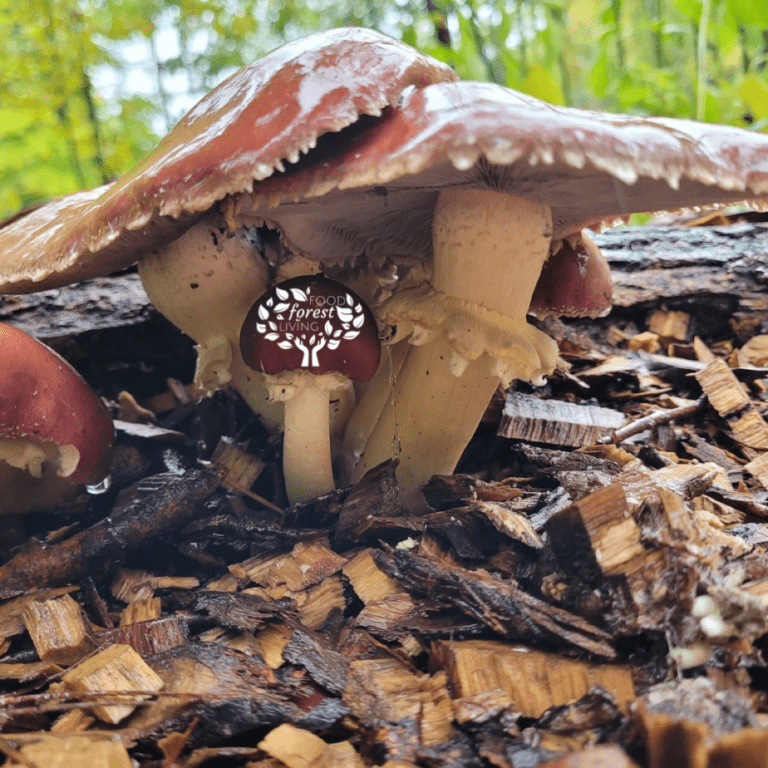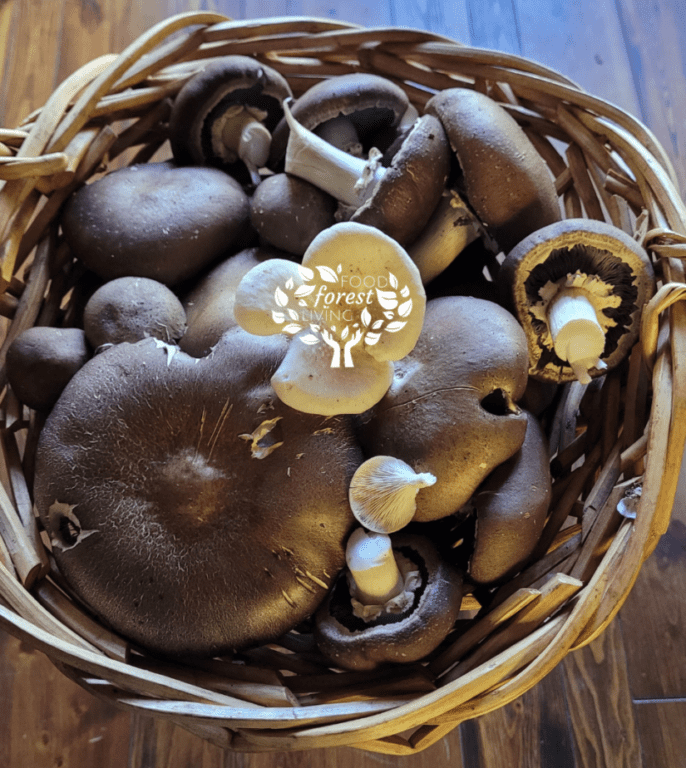This post may contain affiliate links. If you use these links to buy something we may earn a commission. Thanks.
That shaded area you don’t know what to do with can easily be turned into a highly productive mushroom bed.
A mushroom bed is a designated space with layered mulch that acts as food for mushroom spawn (mycelium). Once the mycelium has colonized the materials they will fruit mushrooms and continue to spread and find new food.
Mushroom beds can be made indoors and outdoors. Outdoor beds produce more mushrooms for a longer time and can be topped up with fresh material easily for ongoing production. Indoor mushroom beds can be tricky to maintain, yield less, and cost more to make.
The most costly part about indoor mushroom beds is supplying suitable conditions with equipment and power. A shady space outside already carries the right conditions without demanding your labor of control.
Less control means outdoor mushroom beds are less work. Less control also means more diversity, so don’t be surprised if you end up with a few unexpected mushroom strains growing in your bed. Outdoor beds can be contaminated at any point in time with other wild mushrooms.
Some may be edible, and some may not be. Any of these books will help you to properly identify mushrooms for our area. For outdoor mushroom beds, it is vital that you make sure every mushroom you harvest and eat is the one you know is edible.
Our wine cap mushrooms have been growing alongside this other type of slimy, brown, supposedly edible mushroom that we decided not to try. We have so many wine caps crawling around and are happy to see other mushrooms growing and contributing to soil health for our food forest.
When should I start outdoor mushroom beds?
Mushroom beds are pretty easygoing when it comes to getting started.
The best time to start a mushroom bed is anytime during the growing season and when your growing material (substrate) is freshest. Mixing spawn into fresh substrate during temperatures that allow growth is optimal for reducing competition from wild mushrooms.
All mushrooms and their mycelium grow and a variety of temperatures. So long as you start your beds when frost is not a concern most mushrooms will happily infiltrate the growing medium and fruit in a matter of months.
We started our wine cap mushroom beds in spring and got our first harvest in the fall of the same year. The warmth over summer accelerates the speed of growth of the vegetative (mycelium) state. Once the temperatures cool down and growth has been adequate we get fruit!

This can vary from climate to climate and how you make your mushroom beds.
Some types of material take longer to colonize than others, using a mix of the two can allow you to get fruit faster while also long term.
Your climate may also be longer or shorter than ours. Here in Zone 5 Ontario, Canada, our seasons are just the right length of time to get a mushroom harvest as fast as vegetables.
Can you start a mushroom bed in the fall?
You can start a mushroom bed in the fall for a first harvest next spring. Mushroom beds aren’t picky about when they are started because substrates are easily sourced fresh or dried. Dry materials aren’t contaminated with wild mushrooms.
The worst time to start a mushroom bed is near times of frost and winter. Mycelium grows best in growth temperatures—usually warmer than frosts. By starting your bed in the fall, there will be a chance for some growth before dormancy sets in.
Trees need to grow branches and leaves for energy and space to bear fruit. Allowing time for the mycelium to grow before dormancy temperatures means that there will be adequate vegetative growth to support fruiting in spring.
How long does a mushroom bed last?
Before we started, we wondered if mushroom beds would be like annual vegetables. Having experienced a few years of mushroom bed production we’ve discovered it to be more like growing perennials.
Mushroom beds last for as long as they can find food to colonize and consume. You can encourage your mushroom beds to stay put with regular feeding 1-2 times per season. Or you can let them crawl around by feeding the ground anywhere they can reach.
You can either allow leaves to drop and stay put, or apply straw, woodchips, or sawdust to your beds or nearby the beds.
Mushroom beds aren’t easily controlled to stay stationed in one spot forever. That isn’t a bad thing! Mycelium spreading throughout your space will help nutrients become available in your soil for healthy plants.
However, if you do prefer mushrooms that stay put and don’t walk around, try mushroom logs!
What conditions are needed for a mushroom to grow?
Mushrooms require specific conditions to grow and some strains are pickier than others.
In general, mushroom beds need a place that is cool, shady, and moist, with indirect light, and good drainage to grow well. Fruit will emerge when the preferred temperatures occur which vary by mushroom type.
Where can such environments be found? Here are several examples:
- The shady side of a house, shed, or barn
- Under a deciduous or coniferous canopy
- Under a fun and creative but permanent teepee trellis structure
- On the shady side of a hedge
- On the shady side of a fence
- In a woodland forest
- Under a raised shade cloth
- Under a rhubarb patch
You can either use the shade you have or create shade if you don’t have it.
For our very first mushroom beds, we carefully surrounded 3 fruit tree bases with layers of straw, woodchip mulch, and wine cap spawn. Wine cap mushrooms are the easiest type of mushroom to grow.

This article was originally published on foodforestliving.com. If it is now published on any other site, it was done without permission from the copyright owner.
Since then, we have enjoyed a hundred or so meals with wine cap mushrooms, thus far!
A side note on using fruit tree bases for your mushroom beds:
If you plan to companion plant your fruit trees with a polyculture of herbs and flowers and such, we don’t recommend making it a mushroom bed. If you just want mulch and nothing else beneath your trees, it’s a great space to function as a mushroom bed. Mushroom bed maintenance can become physically tricky to work around later.
You also want to ensure that you correctly mulch your trees. Too much mulch or the wrong placement of mulch can be detrimental to your trees and shrubs.
Up next:
Recent Posts
There’s no shortage of full-sun ground covers for zone 4 climates! Each plant in this list can withstand the frigid temperatures and also enjoy the hot sun in summer. Full sun means that a plant...
There's no shortage of full sun ground covers, not even in zone 3! Zone 3 climates offer hot but short-lived summers and very cold winters. So each plant in this list can withstand the frigid...
